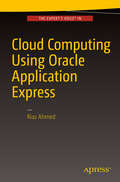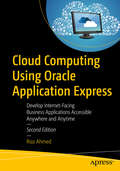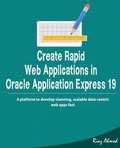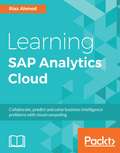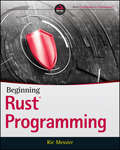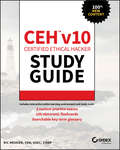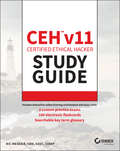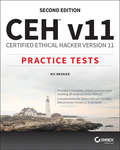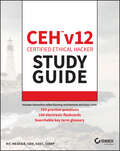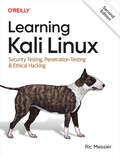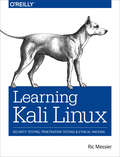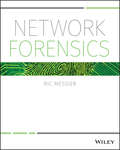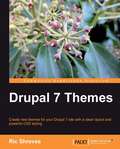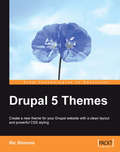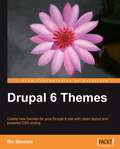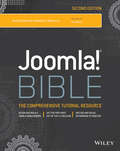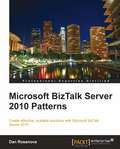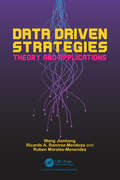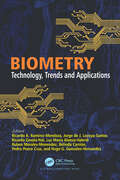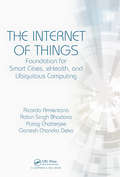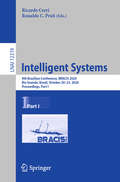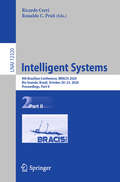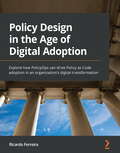- Table View
- List View
Cloud Computing Using Oracle Application Express
by Riaz AhmedDevelop cloud-based applications rapidly using the Oracle Application Express (APEX) platform. You will learn to develop a comprehensive functional business application which can be deployed in your organization. Cloud Computing Using Oracle Application Express will teach you how to develop a complete general ledger accounting system which will be accessible through a variety of devices, including desktops, laptops, and the latest smartphones. What You Will Learn: Use new Oracle APEX 5. 0 techniques Develop a complete general ledger accounting system named The Cloud Accountant Develop cloud-based business apps accessible anywhere and anytime Enhance your APEX development skills Who This Book Is For: Web developers who possess some working knowledge of Oracle Application Express, and developers who have been using Oracle Forms and now wish to use their existing SQL and PL/SQL expertise.
Cloud Computing Using Oracle Application Express: Develop Internet-Facing Business Applications Accessible Anywhere and Anytime
by Riaz AhmedGet the domain knowledge you need to develop real-world business apps for and in the cloud. You’ll see how Oracle APEX has made the life of web developers much easier and how it helps you create web-based data-centric applications easily and instantly without writing screeds of code.In Cloud Computing Using Oracle Application Express, you will develop a complete general ledger accounting system named the Cloud Accountant which will be accessible through a variety of devices including desktops, laptops, and the latest smartphones. This new edition also incorporates the new application page creation process, which differs from the previous version. You’ll cover other new areas, such as the updated UI elements and properties, and the interactive grid. Besides the development of a full application that you can deploy in your organization, the book teaches many new techniques to further enhance your APEX development skills.What You Will LearnDiscover new development techniques for APEX developersDevelop cloud-based ERP applicationsBuild a cloud-based application on Oracle APEXIntegrate the free JasperReports server and report designing tool with Oracle APEXWho This Book Is ForWeb developers who possess some working knowledge of Oracle Application Express, and developers who have been using Oracle Forms and now wish to use their existing SQL and PL/SQL expertise.
Create Rapid Web Applications in Oracle Application Express 19: A platform to develop stunning, scalable data-centric web apps fast
by Riaz AhmedThis book introduces you to the art of building web applications by iteratively developing the sample database application (provided with Oracle APEX) from scratch. The application demonstrates how to display summary information, use reports and forms for viewing, updating, and adding information, include charts and maps to visualize information, and create dedicated mobile pages. Oracle APEX is an amazing development platform in which you can build robust web applications. Not only it provides an environment where you can rapidly develop data-centric web applications, it also allows end-users to interact with their data via tools like interactive report, interactive grid, different types of charts, maps and more. This book helps absolute beginners who wish to learn from self-paced professional guidance and need a solid foundation in Oracle APEX.
Learning SAP Analytics Cloud
by Riaz AhmedStart making better business decisions backed by data About This Book • Predict new opportunities and risks in a few mouse clicks • Eliminate complexity with tools that let you plan, analyze, and collaborate in context—in real time • Discover, visualize, plan, and predict in a single product with agile BI tools Who This Book Is For This book targets IT professionals, business analysts, BI developers, managers, newcomers to SAP Analytics Cloud, and ultimately anyone who wants to learn from self-paced, professional guidance and needs a solid foundation in SAP Analytics Cloud. What You Will Learn • A clear understanding of SAP Analytics Cloud platform • Create data models using different data sources, including Excel and text files . • Present professional analyses using different types of charts, tables, geo maps, and more • Using stories, drill up and down instantly to analyze data from various angles • Share completed stories with other team members or compile them in SAP Digital Boardroom agendas for presentation to major stakeholders • Export the results of a story to a PDF file • Save time by planning, analyzing, predicting, and collaborating in context • Discover, visualize, plan, and predict in one product as opposed to separate solutions In Detail The book starts with the basics of SAP Analytics Cloud (formerly known as SAP BusinessObjects Cloud) and exposes almost every significant feature a beginner needs to master. Packed with illustrations and short, essential, to-the-point descriptions, the book provides a unique learning experience. Your journey of exploration starts with a basic introduction to the SAP Analytics Cloud platform. You will then learn about different segments of the product, such as Models, Stories, Digital Boardroom, and so on. Then, you are introduced to the product's interface: the Home screen, the main menu, and more. Then comes the hands-on aspect of the book, which starts with model creation. Next, you learn how to utilize a model to prepare different types of stories(reports) with the help of charts, tables, Geo Maps, and more. In the final chapters of this book, you will learn about Digital Boardroom, Collaboration, and Administration. Style and approach The easy-to-follow visual instructions provided in this book help business users and report developers create simple and complex stories (reports) quickly
Beginning Rust Programming
by Ric MessierThis is not your typical programming book! Jump right in with interesting, useful programs, some of which are drawn from classic computer science problems as a way of talking about the programming constructs in the language rather than explaining everything in a dry, theoretical manner that doesn’t translate well to implementation.Rust programming has been the "most loved programming language" in the Stack Overflow Developer Survey every year since 2016! Learn why programmers are using Rust due to it's performance and efficency, without the errors and crashes that a programmer would find in common languages such as C and C++. Built around solving real problems, this book will help introduce you to computer science problems that can be built upon to create solutions for other problems. LEARN BY DOING: This book will focus on a practical approach to learing Rust. You will learn all of the language fundamentals through the use of programming examples that do interesting things! All of the programs covered will be based on a computer science problem or othre interesting problems that can be used as a foundation for demonstrating language syntax, data types and structures, and other features or techniques for developing programs.
CEH v10 Certified Ethical Hacker Study Guide
by Ric MessierAs protecting information becomes a rapidly growing concern for today’s businesses, certifications in IT security have become highly desirable, even as the number of certifications has grown. Now you can set yourself apart with the Certified Ethical Hacker (CEH v10) certification. The CEH v10 Certified Ethical Hacker Study Guide offers a comprehensive overview of the CEH certification requirements using concise and easy-to-follow instruction. Chapters are organized by exam objective, with a handy section that maps each objective to its corresponding chapter, so you can keep track of your progress. The text provides thorough coverage of all topics, along with challenging chapter review questions and Exam Essentials, a key feature that identifies critical study areas. Subjects include intrusion detection, DDoS attacks, buffer overflows, virus creation, and more. This study guide goes beyond test prep, providing practical hands-on exercises to reinforce vital skills and real-world scenarios that put what you’ve learned into the context of actual job roles. Gain a unique certification that allows you to understand the mind of a hacker Expand your career opportunities with an IT certificate that satisfies the Department of Defense’s 8570 Directive for Information Assurance positions Fully updated for the 2018 CEH v10 exam, including the latest developments in IT security Access the Sybex online learning center, with chapter review questions, full-length practice exams, hundreds of electronic flashcards, and a glossary of key terms Thanks to its clear organization, all-inclusive coverage, and practical instruction, the CEH v10 Certified Ethical Hacker Study Guide is an excellent resource for anyone who needs to understand the hacking process or anyone who wants to demonstrate their skills as a Certified Ethical Hacker.
CEH v11 Certified Ethical Hacker Study Guide
by Ric MessierAs protecting information continues to be a growing concern for today’s businesses, certifications in IT security have become highly desirable, even as the number of certifications has grown. Now you can set yourself apart with the Certified Ethical Hacker (CEH v11) certification. The CEH v11 Certified Ethical Hacker Study Guide offers a comprehensive overview of the CEH certification requirements using concise and easy-to-follow instructions. Chapters are organized by exam objective, with a handy section that maps each objective to its corresponding chapter, so you can keep track of your progress. The text provides thorough coverage of all topics, along with challenging chapter review questions and Exam Essentials, a key feature that identifies critical study areas. Subjects include common attack practices like reconnaissance and scanning. Also covered are topics like intrusion detection, DoS attacks, buffer overflows, wireless attacks, mobile attacks, Internet of Things (IoT) and more. This study guide goes beyond test prep, providing practical hands-on exercises to reinforce vital skills and real-world scenarios that put what you’ve learned into the context of actual job roles. Gain a unique certification that allows you to function like an attacker, allowing you to identify vulnerabilities so they can be remediated Expand your career opportunities with an IT certificate that satisfies the Department of Defense’s 8570 Directive for Information Assurance positions Fully updated for the 2020 CEH v11 exam, including the latest developments in IT security Access the Sybex online learning center, with chapter review questions, full-length practice exams, hundreds of electronic flashcards, and a glossary of key terms Thanks to its clear organization, all-inclusive coverage, and practical instruction, the CEH v11 Certified Ethical Hacker Study Guide is an excellent resource for anyone who needs to understand the hacking process or anyone who wants to demonstrate their skills as a Certified Ethical Hacker.
CEH v11: Certified Ethical Hacker Version 11 Practice Tests
by Ric MessierMaster CEH v11 and identify your weak spots CEH: Certified Ethical Hacker Version 11 Practice Tests are the ideal preparation for this high-stakes exam. Five complete, unique practice tests are designed to help you identify weak spots in your understanding, so you can direct your preparation efforts efficiently and gain the confidence—and skills—you need to pass. These tests cover all section sections of the exam blueprint, allowing you to test your knowledge of Background, Analysis/Assessment, Security, Tools/Systems/Programs, Procedures/Methodology, Regulation/Policy, and Ethics. Coverage aligns with CEH version 11, including material to test your knowledge of reconnaissance and scanning, cloud, tablet, and mobile and wireless security and attacks, the latest vulnerabilities, and the new emphasis on Internet of Things (IoT). The exams are designed to familiarize CEH candidates with the test format, allowing them to become more comfortable apply their knowledge and skills in a high-pressure test setting. The ideal companion for the Sybex CEH v11 Study Guide, this book is an invaluable tool for anyone aspiring to this highly-regarded certification. Offered by the International Council of Electronic Commerce Consultants, the Certified Ethical Hacker certification is unique in the penetration testing sphere, and requires preparation specific to the CEH exam more than general IT security knowledge. This book of practice tests help you steer your study where it needs to go by giving you a glimpse of exam day while there's still time to prepare. Practice all seven sections of the CEH v11 exam Test your knowledge of security, tools, procedures, and regulations Gauge your understanding of vulnerabilities and threats Master the material well in advance of exam day By getting inside the mind of an attacker, you gain a one-of-a-kind perspective that dramatically boosts your marketability and advancement potential. If you're ready to attempt this unique certification, the CEH: Certified Ethical Hacker Version 11 Practice Tests are the major preparation tool you should not be without.
CEH v12 Certified Ethical Hacker Study Guide with 750 Practice Test Questions (Sybex Study Guide)
by Ric MessierThe latest version of the official study guide for the in-demand CEH certification, now with 750 Practice Test Questions Information security and personal privacy remains a growing concern for businesses in every sector. And even as the number of certifications increases, the Certified Ethical Hacker, Version 12 (CEH v12) maintains its place as one of the most sought-after and in-demand credentials in the industry. In CEH v12 Certified Ethical Hacker Study Guide with 750 Practice Test Questions, you’ll find a comprehensive overview of the CEH certification requirements. Concise and easy-to-follow instructions are combined with intuitive organization that allows you to learn each exam objective in your own time and at your own pace. The Study Guide now contains more end of chapter review questions and more online practice tests. This combines the value from the previous two-book set including a practice test book into a more valuable Study Guide. The book offers thorough and robust coverage of every relevant topic, as well as challenging chapter review questions, even more end of chapter review questions to validate your knowledge, and Exam Essentials, a key feature that identifies important areas for study. There are also twice as many online practice tests included. You’ll learn about common attack practices, like reconnaissance and scanning, intrusion detection, DoS attacks, buffer overflows, wireless attacks, mobile attacks, Internet of Things vulnerabilities, and more. It also provides: Practical, hands-on exercises that reinforce vital, real-world job skills and exam competencies Essential guidance for a certification that meets the requirements of the Department of Defense 8570 Directive for Information Assurance positions Complimentary access to the Sybex online learning center, complete with chapter review questions, full-length practice exams, hundreds of electronic flashcards, and a glossary of key terms The CEH v12 Certified Ethical Hacker Study Guide with 750 Practice Test Questions is your go-to official resource to prep for the challenging CEH v12 exam and a new career in information security and privacy.
Learning Kali Linux: Security Testing, Penetration Testing & Ethical Hacking
by Ric MessierWith hundreds of tools preinstalled, the Kali Linux distribution makes it easier for security professionals to get started with security testing quickly. But with more than 600 tools in its arsenal, Kali Linux can also be overwhelming. The new edition of this practical book covers updates to the tools, including enhanced coverage of forensics and reverse engineering. Author Ric Messier also goes beyond strict security testing by adding coverage on performing forensic analysis, including disk and memory forensics, as well as some basic malware analysis. Explore the breadth of tools available on Kali LinuxUnderstand the value of security testing and examine the testing types availableLearn the basics of penetration testing through the entire attack lifecycleInstall Kali Linux on multiple systems, both physical and virtualDiscover how to use different security-focused toolsStructure a security test around Kali Linux toolsExtend Kali tools to create advanced attack techniquesUse Kali Linux to generate reports once testing is complete
Learning Kali Linux: Security Testing, Penetration Testing, and Ethical Hacking
by Ric MessierWith more than 600 security tools in its arsenal, the Kali Linux distribution can be overwhelming. Experienced and aspiring security professionals alike may find it challenging to select the most appropriate tool for conducting a given test. This practical book covers Kali’s expansive security capabilities and helps you identify the tools you need to conduct a wide range of security tests and penetration tests. You’ll also explore the vulnerabilities that make those tests necessary.Author Ric Messier takes you through the foundations of Kali Linux and explains methods for conducting tests on networks, web applications, wireless security, password vulnerability, and more. You’ll discover different techniques for extending Kali tools and creating your own toolset.Learn tools for stress testing network stacks and applicationsPerform network reconnaissance to determine what’s available to attackersExecute penetration tests using automated exploit tools such as MetasploitUse cracking tools to see if passwords meet complexity requirementsTest wireless capabilities by injecting frames and cracking passwordsAssess web application vulnerabilities with automated or proxy-based toolsCreate advanced attack techniques by extending Kali tools or developing your ownUse Kali Linux to generate reports once testing is complete
Network Forensics
by Ric MessierIntensively hands-on training for real-world network forensics Network Forensics provides a uniquely practical guide for IT and law enforcement professionals seeking a deeper understanding of cybersecurity. This book is hands-on all the way—by dissecting packets, you gain fundamental knowledge that only comes from experience. Real packet captures and log files demonstrate network traffic investigation, and the learn-by-doing approach relates the essential skills that traditional forensics investigators may not have. From network packet analysis to host artifacts to log analysis and beyond, this book emphasizes the critical techniques that bring evidence to light. Network forensics is a growing field, and is becoming increasingly central to law enforcement as cybercrime becomes more and more sophisticated. This book provides an unprecedented level of hands-on training to give investigators the skills they need. Investigate packet captures to examine network communications Locate host-based artifacts and analyze network logs Understand intrusion detection systems—and let them do the legwork Have the right architecture and systems in place ahead of an incident Network data is always changing, and is never saved in one place; an investigator must understand how to examine data over time, which involves specialized skills that go above and beyond memory, mobile, or data forensics. Whether you're preparing for a security certification or just seeking deeper training for a law enforcement or IT role, you can only learn so much from concept; to thoroughly understand something, you need to do it. Network Forensics provides intensive hands-on practice with direct translation to real-world application.
Drupal 5 Themes
by Ric ShrevesThis book is the ideal introduction to theming with Drupal 5. If you want to create a striking new look for your Drupal website, this book is for you. Starting from the basics of theme setup and configuration, you will learn about the Drupal theming architecture and the PHPTemplate engine, and then move on to modifying existing themes and building new themes from scratch. Included is a complete guide to the various style sheets and themeable functions in Drupal 5, making this book a valuable resource even to experienced theme developers. It covers: Creating custom templates Basics of theming in pure PHP Modifying an existing PHPTemplate theme" a step-by-step guide Creating a new PHPTemplate theme" a step-by-step guide Working with forms The main requirements to make use of this book are knowledge of HTML, CSS, and a touch of creativity! Although this book aims to make Drupal theming accessible to designers, theming in Drupal 5 involves writing some PHP code, and a basic knowledge of PHP will be helpful.
Drupal 5 Themes
by Ric ShrevesThis book is the ideal introduction to theming with Drupal 5. If you want to create a striking new look for your Drupal website, this book is for you. Starting from the basics of theme setup and configuration, you will learn about the Drupal theming architecture and the PHPTemplate engine, and then move on to modifying existing themes and building new themes from scratch. Included is a complete guide to the various style sheets and themeable functions in Drupal 5, making this book a valuable resource even to experienced theme developers. It covers: Creating custom templates Basics of theming in pure PHP Modifying an existing PHPTemplate theme" a step-by-step guide Creating a new PHPTemplate theme" a step-by-step guide Working with forms The main requirements to make use of this book are knowledge of HTML, CSS, and a touch of creativity! Although this book aims to make Drupal theming accessible to designers, theming in Drupal 5 involves writing some PHP code, and a basic knowledge of PHP will be helpful.
Drupal 6 Themes
by Ric ShrevesThis book helps you understand the logic behind the theming system employed in Drupal, and how to make it work for you. You will learn key concepts and work through examples with careful, step-by-step instructions. The main requirements to make use of this book are knowledge of HTML, CSS, and a touch of creativity - you don't need to know anything about theming in Drupal, although you should be familiar with the basic operation of the Drupal system. Although this book aims to make Drupal theming accessible to designers, theming in Drupal 6 involves writing some PHP code, and a basic knowledge of PHP will be helpful. Regardless of your technical skills, this book will teach you to design themes for your Drupal websites in the easiest way.
Joomla! Bible (Bible #814)
by Ric ShrevesYour complete guide to the Joomla! content management system Whether you use Joomla! to power a website, intranet, or blog, you'll need a good how-to reference on this complex, but not always intuitive, content management software. Joomla! Bible, Second Edition is that book. It not only brings you up to speed on the changes and extensions that are now part of Joomla! 3.0, it thoroughly covers functions and tasks, including installation, configuration, management, advanced modules, and extended coverage of two key extensions. You'll learn how to obtain code and deploy it to a server; how to obtain, modify, and delete content; how to choose between the Joomla! Platform and the Joomla! CMS; and more. By the time you finish the Joomla! Bible, Second Edition, you'll be well prepared to build and maintain a Joomla!-based website. Walks you through obtaining the Joomla! 3.0 code and how to deploy it to a server, configure the site, create content, and manage content and user hierarchies Helps you get the most out of core modules that provide advanced functionality, including the Polls Module, the Banner Manager, Content Syndication, Newsfeed Aggregation, and others Includes hands-on tutorials and real-world practical applications Whether you're a content manager, website manager, developer, or do-it-yourselfer, make sure you keep Joomla! Bible, Second Edition on hand.
WordPress 3 Cookbook
by Ric ShrevesThis is a Packt Cookbook, which means it contains step-by-step instructions to achieve a particular goal or solve a particular problem. There are plenty of screenshots and explained practical tasks to make comprehension quick and easy. This book is not specifically for developers or programmers; rather it can be used by anyone who wants to get more out of their WordPress blog by following step-by-step instructions. A basic knowledge of PHP/XHTML/CSS/WordPress is desirable but not necessary.
Data Driven Strategies: Theory and Applications
by Ricardo A. Ramirez-Mendoza Ruben Morales-Menendez Wang JianhongA key challenge in science and engineering is to provide a quantitative description of the systems under investigation, leveraging the noisy data collected. Such a description may be a complete mathematical model or a mechanism to return controllers corresponding to new, unseen inputs. Recent advances in the theories are described in detail, along with their applications in engineering. The book aims to develop model-free system analysis and control strategies, i.e., data-driven control from theoretical analysis and engineering applications based only on measured data. The study aims to develop system identification, and combination in advanced control theory, i.e., data-driven control strategy as system and controller are generated from measured data directly. The book reviews the development of system identification and its combination in advanced control theory, i.e., data-driven control strategy, as they all depend on measured data. Firstly, data-driven identification is developed for the closed-loop, nonlinear system and model validation, i.e., obtaining model descriptions from measured data. Secondly, the data-driven idea is combined with some control strategies to be considered data-driven control strategies, such as data-driven model predictive control, data-driven iterative tuning control, and data-driven subspace predictive control. Thirdly data-driven identification and data-driven control strategies are applied to interested engineering. In this context, the book provides algorithms to perform state estimation of dynamical systems from noisy data and some convex optimization algorithms through identification and control problems.
Biometry: Technology, Trends and Applications
by Ricardo A. Ramirez-Mendoza, Jorge de J. Lozoya-Santos, Ricardo Zavala-Yoé, Luz María Alonso-Valerdi, Ruben Morales-Menendez, Belinda Carrión, Pedro Ponce Cruz and Hugo G. Gonzalez-HernandezBiometrics provide quantitative representations of human features, physiological and behavioral. This book is a compilation of biometric technologies developed by various research groups in Tecnologico de Monterrey, Mexico. It provides a summary of biometric systems as a whole, explaining the principles behind physiological and behavioral biometrics and exploring different types of commercial and experimental technologies and current and future applications in the fields of security, military, criminology, healthcare education, business, and marketing. Examples of biometric systems using brain signals or electroencephalography (EEG) are given. Mobile and home EEG use in children’s natural environments is covered. At the same time, some examples focus on the relevance of such technology in monitoring epileptic encephalopathies in children. Using reliable physiological signal acquisition techniques, functional Human Machine Interfaces (HMI) and Brain-Computer Interfaces (BCI) become possible. This is the case of an HMI used for assistive navigation systems, controlled via voice commands, head, and eye movements. A detailed description of the BCI framework is presented, and applications of user-centered BCIs, oriented towards rehabilitation, human performance, and treatment monitoring are explored. Massive data acquisition also plays an essential role in the evolution of biometric systems. Machine learning, deep learning, and Artificial Intelligence (AI) are crucial allies here. They allow the construction of models that can aid in early diagnosis, seizure detection, and data-centered medical decisions. Such techniques will eventually lead to a more concise understanding of humans.
The Internet of Things: Foundation for Smart Cities, eHealth, and Ubiquitous Computing (Advances In Information Security, Privacy, And Ethics Ser.)
by Ricardo Armentano, Robin Singh Bhadoria, Parag Chatterjee and Ganesh Chandra DekaThis book provides a dual perspective on the Internet of Things and ubiquitous computing, along with their applications in healthcare and smart cities. It also covers other interdisciplinary aspects of the Internet of Things like big data, embedded Systems and wireless Sensor Networks. Detailed coverage of the underlying architecture, framework, and state-of the art methodologies form the core of the book.
Intelligent Systems: 9th Brazilian Conference, BRACIS 2020, Rio Grande, Brazil, October 20–23, 2020, Proceedings, Part I (Lecture Notes in Computer Science #12319)
by Ronaldo C. Prati Ricardo CerriThe two-volume set LNAI 12319 and 12320 constitutes the proceedings of the 9th Brazilian Conference on Intelligent Systems, BRACIS 2020, held in Rio Grande, Brazil, in October 2020. The total of 90 papers presented in these two volumes was carefully reviewed and selected from 228 submissions. The contributions are organized in the following topical section: Part I: Evolutionary computation, metaheuristics, constrains and search, combinatorial and numerical optimization; neural networks, deep learning and computer vision; and text mining and natural language processing. Part II: Agent and multi-agent systems, planning and reinforcement learning; knowledge representation, logic and fuzzy systems; machine learning and data mining; and multidisciplinary artificial and computational intelligence and applications.Due to the Corona pandemic BRACIS 2020 was held as a virtual event.
Intelligent Systems: 9th Brazilian Conference, BRACIS 2020, Rio Grande, Brazil, October 20–23, 2020, Proceedings, Part II (Lecture Notes in Computer Science #12320)
by Ronaldo C. Prati Ricardo CerriThe two-volume set LNAI 12319 and 12320 constitutes the proceedings of the 9th Brazilian Conference on Intelligent Systems, BRACIS 2020, held in Rio Grande, Brazil, in October 2020. The total of 90 papers presented in these two volumes was carefully reviewed and selected from 228 submissions. The contributions are organized in the following topical section: Part I: Evolutionary computation, metaheuristics, constrains and search, combinatorial and numerical optimization; neural networks, deep learning and computer vision; and text mining and natural language processing. Part II: Agent and multi-agent systems, planning and reinforcement learning; knowledge representation, logic and fuzzy systems; machine learning and data mining; and multidisciplinary artificial and computational intelligence and applications.Due to the Corona pandemic BRACIS 2020 was held as a virtual event.
Policy Design in the Age of Digital Adoption: Explore how PolicyOps can drive Policy as Code adoption in an organization's digital transformation
by Ricardo FerreiraA proven methodology to build a PolicyOps function and public policy design frameworks for digital adoption, supporting your organization's journey into new paradigms and service models such as Cloud, SaaS, CaaS, FaaS, and DevOpsKey FeaturesUnderstand and define policies that can be consumed across the businessLeverage a framework to embed Policy as Code into the organizationLearn how to use Open Policy Agent and its powerful policy language, RegoBook DescriptionPolicy as Code (PaC) is a powerful paradigm that enables organizations to implement, validate, and measure policies at scale. Policy Design in the Age of Digital Adoption is a comprehensive guide to understanding policies, their design, and implementation for cloud environments using a DevOps-based framework. You'll discover how to create the necessary automation, its integration, and which stakeholders to involve.Complete with essential concepts, practical examples, and self-assessment questions, this book will help you understand policies and how new technologies such as cloud, microservices, and serverless leverage Policy as Code. You'll work with a custom framework to implement PaC in the organization, and advance to integrating policies, guidelines, and regulations into code to enhance the security and resilience posture of the organization. You'll also examine existing tools, evaluate them, and learn a framework to implement PaC so that technical and business teams can collaborate more effectively.By the end of this book, you'll have gained the confidence to design digital policies across your organizational environment.What you will learnUnderstand policies, guidelines, regulations and how they fit together in an organizationDiscover policy-related current challenges brought by digital transformation regarding policiesFind out about Open Policy Engine (OPA) and other policy engines for different environmentsGet to grips with the latest developments in PaC through a review of the literature, toolset, and usageExplore the PaC framework to develop trust at scale, leveraging patterns and best practicesBecome familiar with tool evaluation and selection using real-world examplesWho this book is forFrom decision-makers, such as chief information officers (CIOs) and chief information security officers (CISOs) responsible for affecting change horizontally in an organization, to cloud and DevOps architects and engineers, this book will help professionals involved in designing, implementing, and measuring policies in their organizations. A basic understanding of concepts such as cloud-native technologies, Infrastructure as Code, DevOps, and automation is necessary to get started with this book.
Powerful Command-Line Applications in Go
by Ricardo GerardiWhether you want to automate tasks, analyze data, parse logs, talk to network services, or address other systems requirements, writing your own command-line tool may be the fastest - and perhaps the most fun - way to do it. The Go programming language is a great choice for developing tools that are fast, reliable, and cross-platform. Create command-line tools that work with files, connect to services, and even manage external processes, all while using tests and benchmarks to ensure your programs are fast and correct. When you want to develop cross platform command-line tools that are fast and reliable, use Go, a modern programming language that combines the reliability of compiled languages with the ease of use and flexibility of dynamic typed languages. Work through practical examples to develop elegant and efficient tools by applying Go's rich standard library, its built in support for concurrency, and its expressive syntax. Use Go's integrated testing capabilities to automatically test your tools, ensuring they work reliably even across code refactoring. Develop CLI tools that interact with your users by using common input/output patterns, including environment variables and flags. Handle files to read or persist data, and manipulate paths consistently in cross-platform scenarios. Control processes and handle signals, and use a benchmark driven approach and Go's concurrency primitives to create tools that perform well. Use powerful external libraries such as Cobra to create modern and flexible tools that handle subcommands, and develop tools that interact with databases, APIs, and network services. Finally, leverage what you learned by tackling additional challenges at the end of each chapter. What You Need: Go 1.8 or higher, an internet connection to download the example files and additional libraries, and a text editor to write your programs.
Universos paralelos
by Ricardo HomsLa tecnología informática le han dado a los medios masivos de la comunicación una gran capacidad de convocatoria para unir los consensos de sectores sociales y políticos y, de esta manera, incidir enormemente en la opinión pública. Con esto, sin que estemos conscientes, nos han impuesto los temas que ahora son prioritarios para la sociedad. Universos paralelos nos ofrece una versión de cómo se han conformado, a partir de la tecnología virtual y la globalización, fuerzas ocultas que quieren controlar nuestro estilo de la vida y nuestra mente, y muestra también cómo se han constituido poderes fácticos que deciden en qué clase de mundo debemos vivir. En los últimos años, sin darnos cuenta, hemos vivido en dos mundos: el de nuestra vida cotidiana, y en uno paralelo que no tiene control, que es invisible, pero determinante.
